Lib for the new LCD Display with ILI9341 controller
Dependents: TFT_Test_ILI9341 touch_piirto TFT_banggood TFT_Test_ILI9341-a-fish ... more
Lib for 320*240 Pixel Color LCD with ILI9341 controller. Based on MI0283QT-9 datasheet. The lib is based on the http://mbed.org/cookbook/SPI-driven-QVGA-TFT code for the older LCD board.
The lib is using the 4 line serial data interface. The IM pins have to be set to 1110 (IM3-IM0) to use this mode. It use the SPI hardware.
I have started to speed up the lib with using DMA and direct SPI programming. To do this I have to split the code for the different platforms. To prevent unreadable code with a lot of #ifdef... I have create a new file. The #ifdef definition around is switching between the platforms. I will add the other Nucleo platforms. If you want to support others - see ..._NUCLEO.cpp , port and send me the code to add.
Display 1
If you use the TFT Proto from MikroElektronika http://www.mikroe.com/eng/products/view/474/tft-proto-board/
you have to connect : 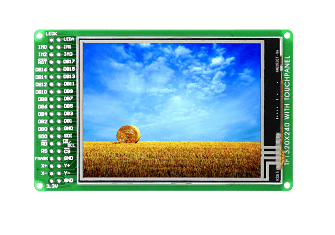
| MBED | Display |
|---|---|
| + 3,3V | 3,3V |
| GND | GND |
| mosi | SDI |
| miso | SDO |
| sck | RS |
| cs | CS |
| reset | RST |
| dc | WR/SCL |
| GND | IM0 |
| +3,3V | IM1 IM2 IM3 |
| GND | DB0 - DB17 |
| GND | RD |
The backlite LED need a resistor to limit the current. You can use two 10R resistors parallel to get 5R driven by 3.3V.
Display 2
Watterott is also selling a ILI9341 based QVGA TFT : http://www.watterott.com/de/MI0283QT-2-Adapter
Unfortunately this adapter is set to 9 bit SPI mode via the mode pins IM0-IM3. If you want to patch this - like I have done - you have to desolder the TFT from the pcb to cut some traces. This is a flexible print. Only for people with soldering skills ! You also have to get access to pin 36 for the dc signal. Cut the GND connection. You can use the level converter used for the LCD_LED signal. Mosfet Q1 can be driven with a logic signal without converter. Watterott will change this in a future revision.
/media/uploads/dreschpe/mi0283qt_v12_patch.pdf
Display 3
There are inexpensive displays from china. You can get them at: http://www.banggood.com/2_2-Inch-Serial-TFT-SPI-LCD-Screen-Module-HD-240-X-320-5110-Compatible-p-912854.html The board has also a SD card connector at the backside, but no touch.
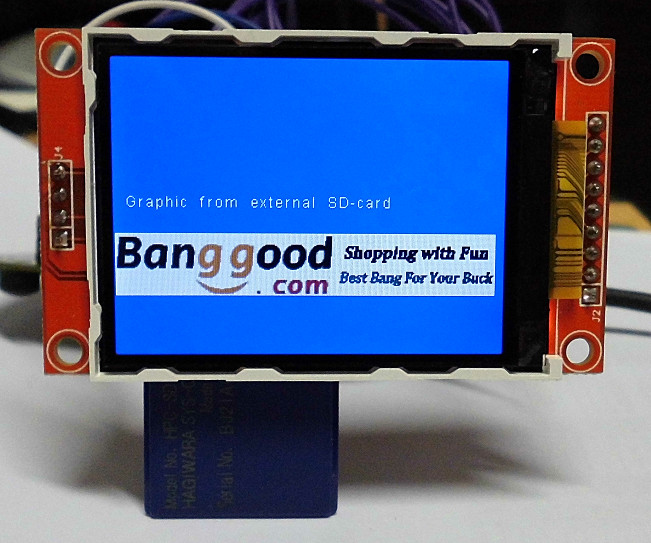
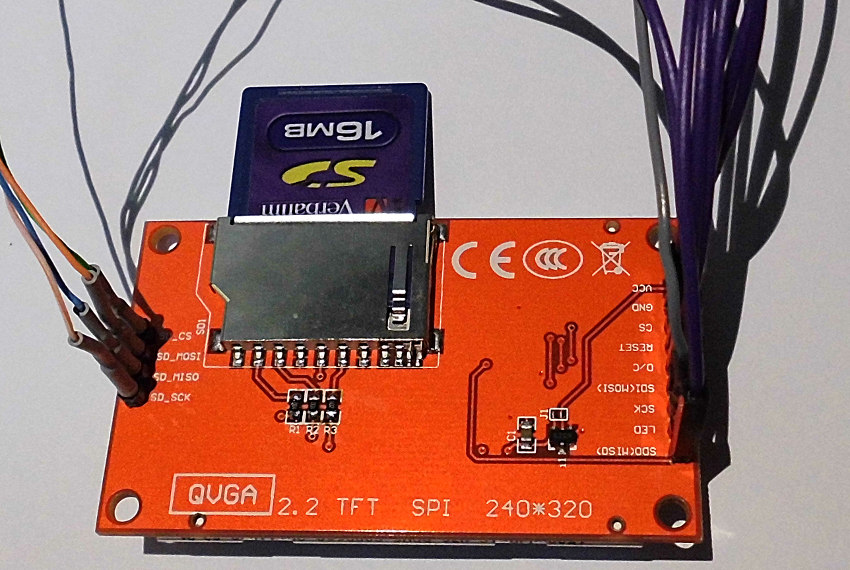
The board can be used without modification. Connect VCC with 5V USB out. There is a voltage regulator on board. To use the SD card simply import the SDFileSystem and connect it to the second SPI.
Fonts
How to get nice looking fonts ?
To print characters to a graphic screen we need a font. To code a font by paper is ok for a small lcd, but for a 320*240 pixel display we need bigger fonts. A 12*12 pixel font is readable, but a lot of work to construct.
Fonts can be made with the GLCD Font Creator also from http://www.mikroe.com .
With this program you can load a window font and convert it into a c-array. To use this Font with my lib you have to add 4 parameter at the beginning of the font array. - the number of byte / char - the vertial size in pixel - the horizontal size in pixel - the number of byte per vertical line (it is vertical size / 8 ) You also have to change the array to char[]. After that you can switch between different fonts with set_font(unsigned char* font); The horizontal size of each character is also stored in the font. It look better if you use bigger fonts or italic. The letter M is wider than a l.
Here are some Fonts from me : http://mbed.org/users/dreschpe/code/TFT_fonts/
The small made for the mbed lab board : http://mbed.org/users/dreschpe/code/LCD_fonts/
And from Peter Holzleitner : http://mbed.org/users/pholzleitner/code/SourceCodePro31-SB/
Text commands :
You can use the claim() function to redirect the output to stdout or stderr to the TFT. After claim(stdout) you can simply use the printf function to print to the TFT.
- locate(x,y); function is used to setup the cursor position. x,y are the pixel position. This was changed from row,column in older lib !
There are two parameter to setup the color of the text :
- background(color);
- foreground(color); All color are 16bit: R5 G6 B5.
- set_orientation(); This command select one of the 4 directions to use the display. This command is also working on the graphical commands.
Graphics
Graphic commands :
- cls(); Fill the screen with background color
- pixel(x,y,color); set a single pixel at x,y with color
- line(x0,y0,x1,y1,color); draw a line from x0,y0 to x1,y1 with color
- rect(x0,y0,x1,y1,color); draw a rectangle x0,y0 to x1,y1 with color
- fillrect(x0,y0,x1,y1,color); draw a filled rectangle
- circle( x0,y0,radius ,color); draw a circle around x0,y0 with radius
- fillcircle(x0,y0,radius ,color); draw a filled circle around x0,y0 with radius
- Bitmap(x0,y0,w,h,*bitmap); paint a bitmap with width w and high h starting at x0,y0 (upper left corner)
- BMP_16(x0,y0,*bmp); paint a bmp file out of the internal drive or a SD-card
How to transfer a grafic to the mbed ?
The hard way - but fast to load :
Load from mbed flash. It consume a lot of flash memory. To construct a bitmap array we can use gimp. http://www.gimp.org/ Load a image (edit and resize) and export it as BMP. You have to select the option 16 bit R5 G6 B5 !
To convert this file into a c-array you can use the hex-editor winhex. (http://www.x-ways.net/winhex/index-m.html) The eval version can handle the small files.
We don`t need the bmp header. Mark the data starting at offset 0x46 to the end of file.
Use "edit -> copy block -> C Source" to export this data as C array. Paste the data into a C file into the mbed compiler.
The editor will generate a array of char[]. To use 16 bit DMA on this we have to put a __align(2) in front of the definition.
To put it into Flash we change it to static const unsigned char bmp[]{...}
__align(2)
static const unsigned char bmp[]{
0xCB, 0x5A, 0x5C, 0xE7,....
};
The easy way - but slower to load:
With the BMP_16 command we can load a picture out of the internal drive or a SD-card to the display.
- BMP_16(x0,y0,"/local/test.bmp"); paint test.bmp out of the internal drive to x0, y0
- BMP_16(x0,y0,"/sd/test.bmp"); paint test.bmp out of a external SD-card to x0, y0
simply copy test.bmp to the mbed usb drive or the SD-card. The bmp has to be saved with the options 16 bit R5 G6 B5 ! You can use the program gimp to convert pictures into the 16 bit bmp format.
sample code
http://mbed.org/users/dreschpe/code/TFT_Test_ILI9341/
// example to test the TFT Display
// Thanks to the GraphicsDisplay and TextDisplay classes
// test2.bmp has to be on the mbed file system
#include "stdio.h"
#include "mbed.h"
#include "SPI_TFT_ILI9341.h"
#include "string"
#include "Arial12x12.h"
#include "Arial24x23.h"
#include "Arial28x28.h"
#include "font_big.h"
extern unsigned char p1[]; // the mbed logo
DigitalOut LCD_LED(p21); // the Watterott display has a backlight switch
DigitalOut CS_Touch(p15); // disable the touch controller on the Watterott display
// the TFT is connected to SPI pin 5-7
SPI_TFT_ILI9341 TFT(p5, p6, p7, p8, p9, p10,"TFT"); // mosi, miso, sclk, cs, reset, dc
int main()
{
int i;
LCD_LED = 1; // backlight on
CS_Touch = 1;
TFT.claim(stdout); // send stdout to the TFT display
//TFT.claim(stderr); // send stderr to the TFT display
TFT.set_orientation(1);
TFT.background(Black); // set background to black
TFT.foreground(White); // set chars to white
TFT.cls(); // clear the screen
//first show the 4 directions
TFT.set_orientation(0);
TFT.background(Black);
TFT.cls();
TFT.set_font((unsigned char*) Arial12x12);
TFT.locate(0,0);
printf(" Hello Mbed 0");
TFT.set_orientation(1);
TFT.locate(0,0);
printf(" Hello Mbed 1");
TFT.set_orientation(2);
TFT.locate(0,0);
printf(" Hello Mbed 2");
TFT.set_orientation(3);
TFT.locate(0,0);
printf(" Hello Mbed 3");
TFT.set_orientation(1);
TFT.set_font((unsigned char*) Arial24x23);
TFT.locate(50,100);
TFT.printf("TFT orientation");
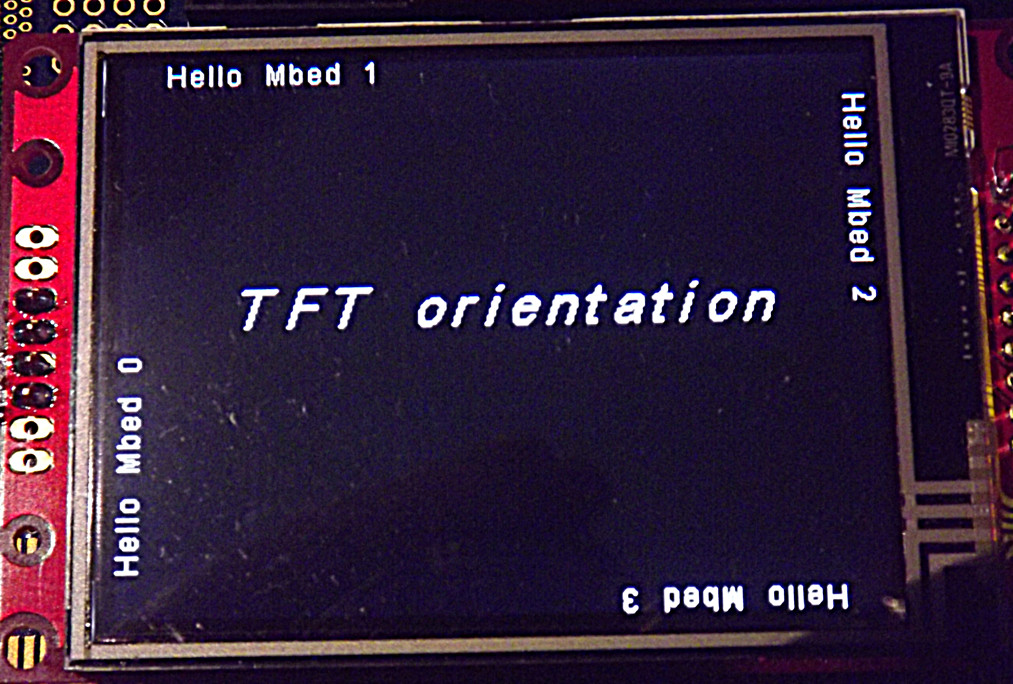
// draw some graphics
TFT.cls();
TFT.set_font((unsigned char*) Arial24x23);
TFT.locate(100,100);
TFT.printf("Graphic");
TFT.line(0,0,100,0,Green);
TFT.line(0,0,0,200,Green);
TFT.line(0,0,100,200,Green);
TFT.rect(100,50,150,100,Red);
TFT.fillrect(180,25,220,70,Blue);
TFT.circle(80,150,33,White);
TFT.fillcircle(160,190,20,Yellow);
double s;
for (i=0; i<320; i++) {
s =20 * sin((long double) i / 10 );
TFT.pixel(i,100 + (int)s ,Red);
}
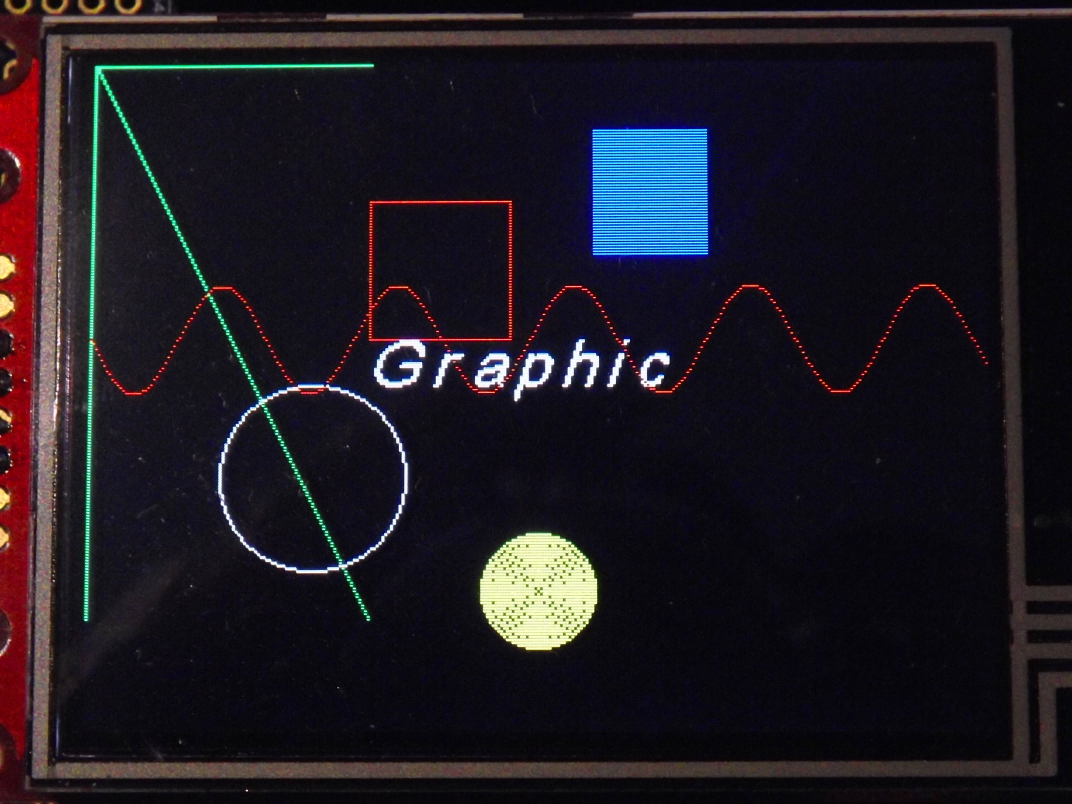
// bigger text
TFT.foreground(White);
TFT.background(Blue);
TFT.cls();
TFT.set_font((unsigned char*) Arial24x23);
TFT.locate(0,0);
TFT.printf("Different Fonts :");
TFT.set_font((unsigned char*) Neu42x35);
TFT.locate(0,30);
TFT.printf("Hello Mbed 1");
TFT.set_font((unsigned char*) Arial24x23);
TFT.locate(20,80);
TFT.printf("Hello Mbed 2");
TFT.set_font((unsigned char*) Arial12x12);
TFT.locate(35,120);
TFT.printf("Hello Mbed 3");
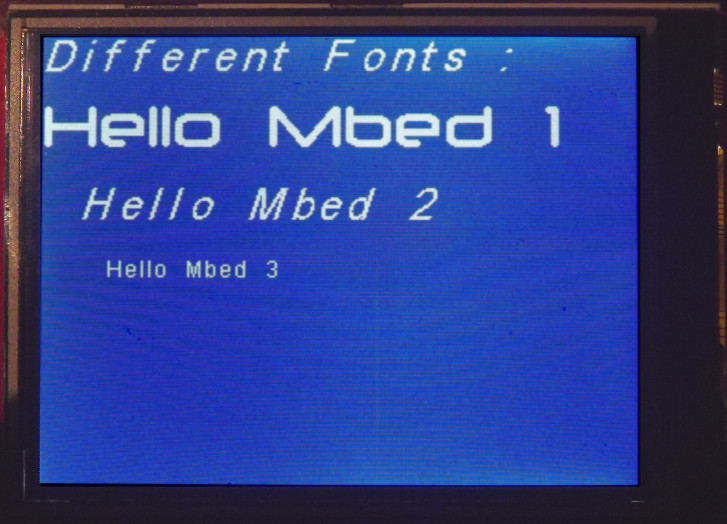
// mbed logo from flash
// defined in graphics.c
//__align(4)
//unsigned char p1[18920] = {
//0xFF, 0xFF, 0xFF, 0xFF, 0xFF, 0xFF, ....
//
TFT.background(Black);
TFT.cls();
TFT.locate(10,10);
TFT.printf("Graphic from Flash");
TFT.Bitmap(90,90,172,55,p1);

#include "SDFileSystem.h"
// connect a sd-card to the second spi or use the local filesystem of the LPC
SDFileSystem sd(p11, p12, p13, p14, "sd"); // mosi,miso,sck,cs
TFT.cls();
TFT.locate(10,110);
TFT.printf("Graphic from external SD-card");
int err = TFT.BMP_16(1,140,"/sd/test.bmp"); // load test.bmp from external SD-card
TFT.locate(10,120);
if (err != 1) TFT.printf(" - Err: %d",err);
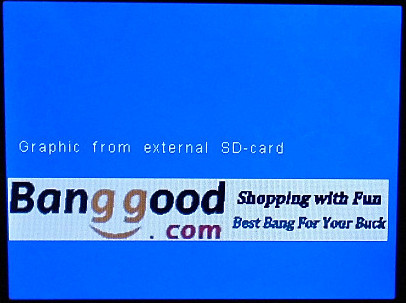
Files at revision 13:b2b3e5430f81
| Name | Size | Actions |
|---|---|---|
| [up] | ||
| GraphicsDisplay.cpp | 6610 | Revisions Annotate |
| GraphicsDisplay.h | 1624 | Revisions Annotate |
| SPI_TFT_ILI9341.cpp | 20770 | Revisions Annotate |
| SPI_TFT_ILI9341.h | 11931 | Revisions Annotate |
| SPI_TFT_ILI9341_NUCLEO.cpp | 28144 | Revisions Annotate |
| SPI_TFT_ILI9341_NXP.cpp | 23299 | Revisions Annotate |
| TextDisplay.cpp | 1834 | Revisions Annotate |
| TextDisplay.h | 2364 | Revisions Annotate |
 Seeed Studio 2.8'' TFT Touch Shield V2.0
Seeed Studio 2.8'' TFT Touch Shield V2.0
 2.2 QVGA display with SD card socket
2.2 QVGA display with SD card socket